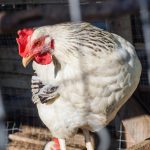Chickens, like all animals, have specific needs that must be met for optimal health and well-being, particularly during winter. These needs include warmth, protection from harsh weather, access to unfrozen water and food, and proper ventilation to prevent respiratory issues. Extra bedding and nesting materials are essential for insulation and comfort.
Different chicken breeds have varying cold tolerances, so it’s important to consider the specific requirements of your flock when preparing for winter. While chickens have some natural adaptations to cold weather, such as fluffing their feathers to create an insulating layer of air, they still require human assistance to maintain their body temperature and overall health during prolonged cold periods. A warm, dry shelter protected from drafts is crucial.
Understanding these fundamental needs allows chicken keepers to take appropriate measures to ensure their flock’s well-being throughout the winter months.
Table of Contents
- 1 Providing proper shelter and insulation
- 2 Using heat lamps and heating pads
- 3 Providing extra bedding and nesting materials
- 4 Ensuring access to fresh water and food
- 5 Maintaining good ventilation while keeping chickens warm
- 6 Monitoring the health and behavior of chickens in winter
- 7 FAQs
- 7.1 What are some ways to keep chickens warm in the winter?
- 7.2 How can I insulate my chicken coop for the winter?
- 7.3 Is it safe to use heat lamps or heated pads for chickens in the winter?
- 7.4 What should I feed my chickens in the winter to help keep them warm?
- 7.5 How can I prevent frostbite in my chickens during the winter?
Key Takeaways
- Chickens need extra care in winter due to their susceptibility to cold temperatures
- Proper shelter and insulation are essential to protect chickens from harsh weather conditions
- Heat lamps and heating pads can be used to provide additional warmth in the coop
- Extra bedding and nesting materials help chickens stay warm and comfortable
- Access to fresh water and food is crucial for the health and well-being of chickens in winter
- Good ventilation is important to prevent moisture buildup while keeping chickens warm
- Regular monitoring of the health and behavior of chickens is necessary to ensure they are coping well with winter conditions
Providing proper shelter and insulation
Insulating the Coop
One of the most important aspects of caring for chickens in winter is providing them with a proper shelter that offers protection from the cold and dampness. The coop should be well-insulated to retain heat and keep out drafts, while also allowing for adequate ventilation to prevent moisture buildup. Insulating the walls and ceiling of the coop with materials such as straw, hay, or foam board can help retain heat and keep the chickens warm.
Sealing Gaps and Cracks
Additionally, sealing any gaps or cracks in the coop will prevent drafts from entering and chilling the birds. It’s also important to ensure that the coop is dry, as dampness can lead to frostbite and respiratory issues in chickens.
Creating a Comfortable Roosting Area
In addition to insulating the coop, providing a dry and comfortable roosting area is essential for keeping chickens warm in winter. Elevating the roosts off the ground can help prevent cold drafts from reaching the birds while they sleep. Adding extra bedding such as straw or wood shavings can provide additional insulation and warmth. It’s also important to regularly clean and replace bedding to maintain a dry and hygienic environment for the chickens.
By providing proper shelter and insulation, you can help your chickens stay warm and comfortable throughout the winter months.
Using heat lamps and heating pads

In some cases, especially in extremely cold climates, providing supplemental heat with heat lamps or heating pads may be necessary to keep chickens warm in winter. Heat lamps can be hung in the coop to provide a source of warmth, especially during particularly cold nights. It’s important to position heat lamps safely to prevent fire hazards and ensure that they are securely attached to prevent accidental falls.
Heating pads designed specifically for poultry can also be placed under the roosting area to provide additional warmth. However, it’s crucial to monitor the temperature in the coop when using supplemental heat to prevent overheating or fires. When using heat lamps or heating pads, it’s important to consider the specific needs of your flock and adjust the level of heat accordingly.
Some chicken breeds are more cold-tolerant than others and may not require supplemental heat unless temperatures are extremely low. Additionally, it’s important to provide a gradual transition from heated areas to cooler areas within the coop to allow chickens to acclimate to varying temperatures. By using heat lamps and heating pads responsibly, you can provide additional warmth for your chickens without compromising their safety.
Providing extra bedding and nesting materials
During the winter months, it’s essential to provide extra bedding and nesting materials to help keep chickens warm and comfortable. Adding a thick layer of straw or wood shavings to the floor of the coop can provide insulation from the cold ground and help retain heat. Nesting boxes should also be filled with clean and dry bedding to provide a warm and cozy environment for hens to lay their eggs.
Additionally, providing extra nesting materials such as straw or shredded paper can help chickens create warm nests for brooding or resting. Regularly cleaning and replacing bedding is crucial for maintaining a dry and hygienic environment for chickens in winter. Wet or soiled bedding can lead to dampness, which can contribute to frostbite and respiratory issues in chickens.
By providing ample bedding and nesting materials, you can help your chickens stay warm and comfortable throughout the winter months.
Ensuring access to fresh water and food
Access to fresh water and food is essential for chickens year-round, but it becomes especially challenging during the winter months when temperatures drop below freezing. It’s important to regularly check waterers and ensure that they are not frozen. Using heated waterers or adding a small amount of apple cider vinegar to the water can help prevent freezing.
Additionally, providing warm water multiple times a day can help ensure that chickens stay hydrated during cold weather. In terms of food, it’s important to provide a balanced diet that meets the nutritional needs of chickens in winter. Feeding a high-quality layer feed supplemented with scratch grains or cracked corn can help provide extra energy for maintaining body temperature in cold weather.
Additionally, offering treats such as mealworms or black oil sunflower seeds can provide extra calories and entertainment for chickens during the winter months. By ensuring access to fresh water and a nutritious diet, you can help your chickens stay healthy and hydrated throughout the winter.
Maintaining good ventilation while keeping chickens warm

Ventilation: The Key to Good Air Quality
Proper ventilation is essential for maintaining good air quality in the chicken coop, especially during the winter months. While it may seem counterintuitive, adequate ventilation helps prevent moisture buildup from chicken droppings and respiration, which can lead to respiratory issues if not properly managed. Ventilation also helps regulate humidity levels in the coop, which is important for preventing frostbite on chicken combs and wattles.
Adjustable Vents for Optimal Airflow
To maintain good ventilation while keeping chickens warm, it’s important to provide adjustable vents that can be opened or closed depending on weather conditions. This allows for airflow without creating drafts that could chill the birds. Additionally, positioning vents near the roof of the coop can help prevent cold air from directly reaching the chickens while still allowing for proper air circulation.
Benefits of Good Ventilation
By maintaining good ventilation, you can ensure that your chickens have access to fresh air while staying warm and comfortable in their coop during the winter months. This is crucial for their overall health and well-being, and can help prevent a range of health issues associated with poor air quality.
Monitoring the health and behavior of chickens in winter
Monitoring the health and behavior of chickens in winter is essential for identifying any potential issues and taking prompt action to address them. Regularly observing your flock for signs of illness or distress, such as lethargy, decreased appetite, or abnormal behavior, can help you identify any health concerns early on. Additionally, checking for signs of frostbite on combs, wattles, or feet is important for preventing long-term damage.
It’s also important to monitor egg production during the winter months, as cold temperatures and decreased daylight hours can impact laying patterns. Providing supplemental light in the coop can help stimulate egg production during the darker months. By monitoring the health and behavior of your chickens in winter, you can proactively address any issues that arise and ensure that your flock stays healthy and happy throughout the colder months.
In conclusion, understanding the needs of chickens in winter is essential for providing proper care and ensuring their well-being during the colder months. By providing a warm and dry shelter, insulating the coop, using heat lamps or heating pads responsibly, providing extra bedding and nesting materials, ensuring access to fresh water and food, maintaining good ventilation, and monitoring their health and behavior, you can help your chickens stay healthy and comfortable throughout the winter season. With proper care and attention, your flock can thrive even in cold weather conditions.
If you’re looking for tips on how to keep your chickens warm in the winter, you might also be interested in learning about different types of chicken coops. Check out this article on how to convert a shed into a chicken coop for some helpful ideas on creating a cozy and insulated space for your feathered friends during the colder months.
FAQs
What are some ways to keep chickens warm in the winter?
Some ways to keep chickens warm in the winter include providing a well-insulated coop, using heat lamps or heated pads, and ensuring good ventilation while avoiding drafts.
How can I insulate my chicken coop for the winter?
You can insulate your chicken coop by adding extra bedding, sealing any drafts, and using insulating materials such as foam board or straw bales.
Is it safe to use heat lamps or heated pads for chickens in the winter?
It can be safe to use heat lamps or heated pads for chickens in the winter, but it’s important to follow safety guidelines and ensure that the heating devices are securely installed to prevent fire hazards.
What should I feed my chickens in the winter to help keep them warm?
In the winter, you can feed your chickens high-energy foods such as cracked corn or sunflower seeds to help keep them warm. It’s also important to ensure they have access to fresh water at all times.
How can I prevent frostbite in my chickens during the winter?
To prevent frostbite in chickens during the winter, make sure the coop is well-ventilated to prevent moisture buildup, provide roosts with wide flat surfaces for them to perch on, and consider using petroleum jelly on their combs and wattles.
Meet Walter, the feathered-friend fanatic of Florida! Nestled in the sunshine state, Walter struts through life with his feathered companions, clucking his way to happiness. With a coop that’s fancier than a five-star hotel, he’s the Don Juan of the chicken world. When he’s not teaching his hens to do the cha-cha, you’ll find him in a heated debate with his prized rooster, Sir Clucks-a-Lot. Walter’s poultry passion is no yolk; he’s the sunny-side-up guy you never knew you needed in your flock of friends!







